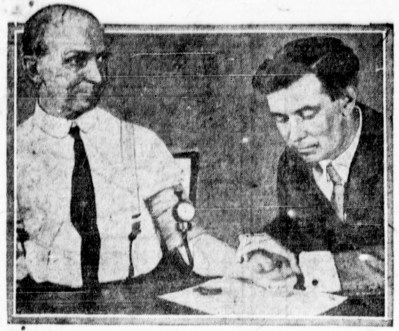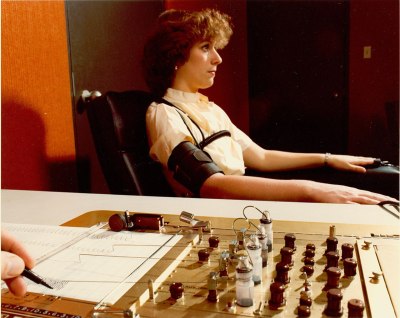 You might think it is strange that a story about technology would start off talking about Wonder Woman. When you realize the technology in question is a lie detector, you might think, “Oh, that’s right. Wonder Woman had the lasso of truth, so this is just a lame association.” You might think that, but you’d be wrong. Turns out, Wonder Woman and real life polygraphs have a much deeper connection; both the polygraph and Wonder Woman share a common creator.
You might think it is strange that a story about technology would start off talking about Wonder Woman. When you realize the technology in question is a lie detector, you might think, “Oh, that’s right. Wonder Woman had the lasso of truth, so this is just a lame association.” You might think that, but you’d be wrong. Turns out, Wonder Woman and real life polygraphs have a much deeper connection; both the polygraph and Wonder Woman share a common creator.
It makes a good story to say that William Marston — an internationally famous psychologist — created the polygraph, but as you might expect it wasn’t the result of a single person’s effort. However, Marston played a key role and also was behind promoting the technology. So, too, even though he is credited as Wonder Woman’s sole creator, the truth is probably a bit more complex.
 The real wonder of Wonder Woman is that she exists at all. In 1942, a powerful female superhero was a pretty bold marketing risk. The fact that she was “not sufficiently dressed” (as one critic reported) didn’t help, either. Comic books were still relatively new media in 1942. Superman dates back to 1938 and Batman to 1939. Some would argue there weren’t any modern comic books before 1933 when Maxwell Gaines devised the first four-color saddle-stitched newsprint magazine. Like all new media, the old media was not amused. Respected newspapers called them “sex-horror serials” and a “national disgrace.”
The real wonder of Wonder Woman is that she exists at all. In 1942, a powerful female superhero was a pretty bold marketing risk. The fact that she was “not sufficiently dressed” (as one critic reported) didn’t help, either. Comic books were still relatively new media in 1942. Superman dates back to 1938 and Batman to 1939. Some would argue there weren’t any modern comic books before 1933 when Maxwell Gaines devised the first four-color saddle-stitched newsprint magazine. Like all new media, the old media was not amused. Respected newspapers called them “sex-horror serials” and a “national disgrace.”
Granted, in the 1940’s comics did have a lot of things that were objectionable. Female characters were often relegated to the “Damsel in Distress” plotline. Tied down to railroad tracks or at threat of being burnt at the stake, the hero would arrive in the nick of time and save the day so you never actually dealt with the burned or dismembered corpse of the heroine.
With the Wonder Woman comic, Marston set out to break this tired mold. In 1940, a reporter named Olive Richard interviewed Marston who said he saw “great educational potential” in comic books. This comment caught the attention of Maxwell Gaines who ran All-American Comics, along with the co-owner of Detective Comics (which would become DC), Harry Donenfield. The two comic publishers maintained close relations until Donenfeld bought out Gaines in 1946. In 1940, Gaines decided to create an editorial advisory board and hired Marston to serve on it. New to the comic scene, Marston was already well-known in other fields.
Truth, Behavior, and the Origins of Wonder Woman
To say William Marston had an unconventional life is like saying Jupiter is large. He had three degrees from Harvard, one a PhD in psychology. He had worked as a lawyer and as a professor. In 1928 he wrote a paper about DISC theory, which formed the basis for an early behavioral assessment test.
 Marston’s wife Elizabeth Halloway Marston, herself an attorney and psychologist, once observed that when she got mad or excited her blood pressure would go up. This led William to experiment with observing blood pressure changes as an indicator of prevarication (a sneaky lie). This became one part of the modern polygraph, created by John Larson.
Marston’s wife Elizabeth Halloway Marston, herself an attorney and psychologist, once observed that when she got mad or excited her blood pressure would go up. This led William to experiment with observing blood pressure changes as an indicator of prevarication (a sneaky lie). This became one part of the modern polygraph, created by John Larson.
Marston did a lot of work with the polygraph, trying to commercialize it. As a result of his work, he became convinced that women were more honest than men and he also thought they could work faster and more accurately at many jobs. This was pretty radical thinking for the 1930s.
While Elizabeth was instrumental in suggesting the link between telling a lie and blood pressure, there was another woman in William’s life, too. In 1925, William was Olive Byrne’s psychology professor at Tufts University. They fell in love and William gave his wife an ultimatum. Olive would come to live with them or he would leave her to be with her. While a polyamorous relationship isn’t that scandalous these days, in 1925 it was not something most people would even think about. They lived as a family and Marston had two children with each woman. The Marston’s officially adopted Byrne’s children, doubtlessly for legal reasons.
Oh, and Olive Byrne’s pen name was Olive Richard: the same person who wrote the interview that brought Marston to the attention of comic book publisher Gaines. Even after Marston’s death, the women continued to live together as a family.
The Comic Connection
As part of the editorial board, Marston noted that the biggest problem with comics was their “blood-curdling masculinity.” He apparently shared with Elizabeth that he envisioned a superhero that would conquer with love instead of fists or firepower. Elizabeth suggested he make her a woman. Gaines was receptive to the idea. However, he told Marston he’d have to write the strip himself.
Marston developed Wonder Woman as a powerful female lead modeled partly after Elizabeth and William’s life partner Olive. In the comics, Wonder Woman was given a golden lasso. While bound with it, anyone was compelled to tell her the truth and do as she commanded. The lasso worked much better than a polygraph — actually compelling the person to tell the truth — but the influence is clear.
Polygraph
The modern polygraph uses blood pressure as one test out of many. Marston actually wasn’t the first to attempt this. In 1895, Cesare Lombroso tried the same thing with some success. Marston’s own work was on German prisoners of war and showed a strong correlation between lying and systolic blood pressure.
 Other items polygraphs can measure include breathing, pulse, galvanic skin response, and muscular activity. The subject is asked a set of pretest questions to establish a baseline and measure reactions when the subject is being deceptive. Responses are then recorded during the interview and compared to the pretest measurements.
Other items polygraphs can measure include breathing, pulse, galvanic skin response, and muscular activity. The subject is asked a set of pretest questions to establish a baseline and measure reactions when the subject is being deceptive. Responses are then recorded during the interview and compared to the pretest measurements.
Does it work? It apparently does, but not universally. There are many instances of people lying yet passing polygraph tests. There is also a fear of false positives, and there have been many high profile cases of that, too. For these reasons, polygraph tests are usually inadmissible in court.
Some think that the way an examiner administers the test can cause enough anxiety in an innocent person to sway the test and there are methods for attempting to negate that effect. In Japan, for example, the examiner doesn’t know the details of the crime and asks questions in multiple choice format. The examiner isn’t really looking at the answers, but the reaction to the potential answers which can then match up with the known correct answers.
Sometimes, though, just the idea of a polygraph is enough to compel people to tell the truth. This is sometimes known as the “bogus pipeline” where a researcher will connect a subject to meaningless wires and told it is a polygraph. People are apparently less likely to lie in that situation.
Cleve Backster was a polygraph operator with the CIA. He used the machine to show that plants feel pain and have ESP. Of course, the scientific community didn’t find his experiments compelling.
There are several other lie detection technologies and strategies ranging from microexpression analysis, the silent talker detector, and voice stress analysis. We can’t help but wonder if anyone has just thought about feeding a bunch of videos into a machine learning system. We certainly have plenty of videos of people lying. Being sure about the truthful videos might be a little harder.
Meanwhile, next time you see Wonder Woman use her lasso of truth, you’ll think about the unconventional Dr. Marston and his connection to the lie detector. Not to mention the visionary creation of a female superhero at a time when that was almost unthinkable.
















At my age, I no longer care, so call me a sexist. My wife, has a built-in ‘lasso of truth’ – her eyes. My married male friends all suffer from their wife’s similar powers.
When I was in the military (back when we mounted bombs on pterosaurs, and armed infantry with lances) , knew a guy that operated polygraphs. He claimed that to reveal anything, the test subject had to have a sense ethics, and perhaps some sort of moral code belief system, and that false positives were common.
And this is what Martson wrote.
https://archive.org/details/emotionsofnormal032195mbp/page/n8
*Borat voice* My wife
“There are several other lie detection technologies and strategies ranging from microexpression analysis, the silent talker detector, and voice stress analysis.”
What about brainwaves?
(wraps alumin[i]um foil around upper skull)
no its real ren…
You need real tin foil. Alumin[i]um just makes a convenient wave guide. Tin Egyptian style shoulder collar and copper Farady cage knit chainmail with hoody also useful and very quasi futuristic fashion. Could just go with classic iron armor but terribly outdated fashion. Ha
Sans grounding… It would be ineffective. Google portable SCIFs for POTUS
“There are several other lie detection technologies and strategies ranging from microexpression analysis, the silent talker detector, and voice stress analysis.”
What about brainwaves?
https://en.wikipedia.org/wiki/Silent_Talker_Lie_Detector
I must say first time hearing about this. Invented about 20 years ago. Darn!
VSA off the TV is illegal in California USA (only if you publish it) so don’t use it on politicians and then Twitter it. The Israelis made a nice one called TRUSTER. Sold it to an American company I think.
Brainwaves – I think they called it SQUID because of the EEG cap looks like a squid. You look at photos and they look for thermal hot spots in your brain. I think the thermal activity means you are responding mentally to the photo. You don’t have to do anything. I think a Norwegian company developed an invasive probe for your scalp. The SQUID is non-invasive but really looks silly.
Maybe HaD’ers can hack MindFlex to do this with an Arduino? Rudimentary of course as it only reads the sides (temples) and your ear lobes. SilentTalker only needs a webcam and a computer. Software should be available soon from MMU in UK????
I’m only Brainstorming…
I think its called MEG not EEG as it uses magnetic sensors of sorts. Here’s some photos: https://www.bing.com/images/search?q=EEG+Cap&FORM=IRIBIP
Correct… https://www.insidescience.org/video/squid
Oh!!! Here it is: https://www.silent-talker.com/
SQUID stands for “superconducting quantum interference device”.
Correct….https://www.insidescience.org/video/squid
I think they use a SQUID in the movie SALT in where they are interogating the Russian SVR defector to see if he was legit.
ctrl+f
“bondage”
Phrase not found
Hmmmmmmmm
+1
any sort of lie detection system that relies on biometrics will never be 100% accurate nor should they ever be used in any sort of legal capacity as a person with very little training can alter things such as their blood pressure, heart rate, eye focus, etc etc. We have been conditioned as a society that these things are reliable and useful, but until they are studied in a proper scientific manner (double blind with a placebo group and large enough sample size to properly extrapolate to the larger population) they are nothing more than a gimick, intimidation tatic or snake oil to be sold depending on where you stand in relation to the machine.
There is a reason that all science is based on repeatable experiments instead of relying on people to tell the truth. Its because “truth” is a relative thing based on your knowledge level and level of belief. The existance of a god is true to some people and not to others for example, being able to compel the truth in people is a fools errand as you are only ever able to get what that person believes to be true in the relative sense and given how unreliable our memories are and how unknown the inner workings of our brains are, it is almost impossible to say with any certainty that any device would be able to tell if a person is telling the truth or not.
That’s why they’re called ’lie detectors’ and not ’truth detectors’…
Picks up politicians a fair distance.
Not as much as you’d think, a lot of them believe their own BS
Interesting timing. I just listened to an interview with an ex-cop who’s on a crusade against the use of lie-detectors.
https://www.jordanharbinger.com/doug-williams-the-truth-about-polygraphs-and-lie-detection/
I heard of the general connection before but this is pretty wild, especially the 1930’s polyamoury!
“Cleve Backster was a polygraph operator… He used the machine to show that plants feel pain and have ESP”
How do you take a plant’s blood pressure? Sap pressure?
And this abbreviated recounting of the tale omits most of the more lurid details. A possible reason that Wonder Woman looks and dresses like she does, and uses a golden lasso to tie up bad men who tell lies is because it’s suspected that they were into such things in private.
Robert Kirkman (one of the authors of the Walking Dead comics) also produced an interesting little series, The Secret History of Comics. S.1 Ep.2 was [The Truth About Wonder Woman.](https://www.amc.com/shows/robert-kirkmans-secret-history-of-comics/season-1/episode-02/the-truth-about-wonder-woman) , which was far-and-away the best episode of the series. While much is a dramatization of speculation (of course), the conclusions aren’t all that improbable based on the evidence.
Thanks.
I’ve read a little bit about Cleve Backster and it’s captivating.
The polygraph he used was measuring electrical potential variations on the plants.
His researches gave incredible results, the main incredible thing is that very few people have heard about it :
plants are alive… and they feel things.
I’m sure he did pick up electrical variations but you can get EEG readings from jello. As for plants being alive, of course they are, they even communicate with each other chemically, but having no nervous system giving them a polygraph is jusrt silly.
Evidently with a high enuf ‘ res camera, you can play back a video of a house plant and decode the vibrations from human conversations in the room. All sounds actually.
Didn’t she have a Nazi supervillan named Polly Graf?
The best argument against trusting polygraphs is Aldrich Ames. He rose to become head of the CIA, the most polygraphed operation in America, if not the world, and for years nobody twigged that he was lying when he said he wasn’t a Soviet spy. Either the polygraph didn’t pick up that he was lying, in which case it is useless, or it did but nobody believed it, in which case the CIA thought it was useless.
Technically they are not LIE detectors, they are just stress detectors. Ames was not the head of CIA and not a KGB spy. He was a CIA officer that was turned mole because he needed money. So he beat the box every 5 years by convincing himself he was not a spy. Semantics I guess. He’s sitting in Indiana right now thinking about the cluster phuq he caused…
Need to ask him about his Putin connection…
Hah, the *average* politician’s nightmare.
“Does it work? It apparently does, but not universally.”
This doesn’t seem to be quite true. As in the claim, “a stopped clock is right twice a day,” there are not any times during the day where using that clock will tell you what time it is. There is merely an illusion possible at certain times.
It is always a lie to say that a polygraph detects lies. It detects discomfort. Discomfort is sometimes correlated with dishonesty, but the presence of discomfort never works as a lie detector. There are no cases where it can tell you if the discomfort detected is also correlated with a lie. It is exactly as accurate as a stopped clock.
Quotes like above in popular culture are the only reason that people still thinks it sometimes works. It is completely circular.